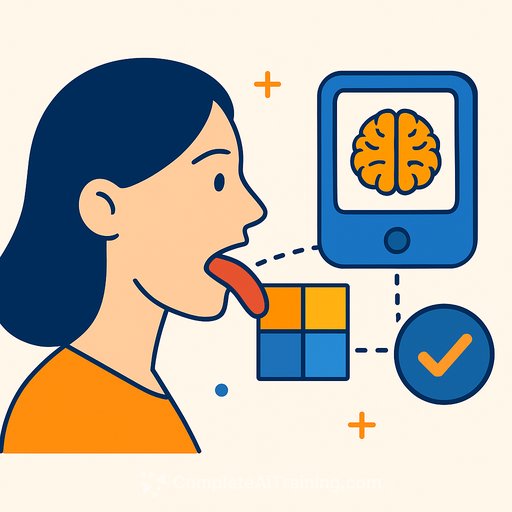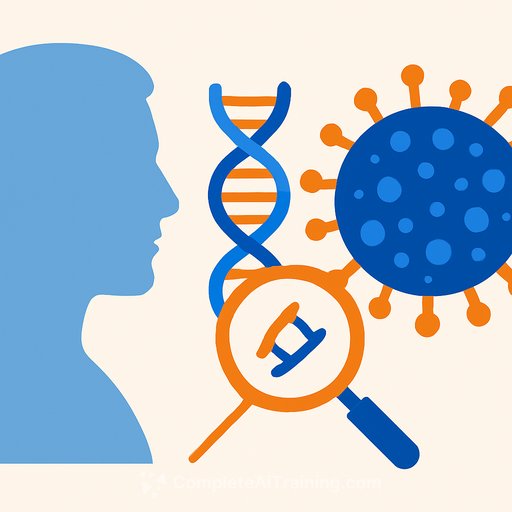AI Reads Tongue Color to Flag Hidden Disease Risks
For centuries, traditional Chinese medicine has treated the tongue as a vital signal. Color, coating, and subtle shifts are read as clues. Now, machine learning is turning those qualitative impressions into measurable biomarkers-with promising but early results.
Recent work reports tongue-color analysis reaching 96.6 percent testing accuracy for classifying disease-linked states under controlled lighting. A small on-site evaluation matched 58 of 60 clinical records. That's intriguing signal-not a clinical endpoint.
Why Tongue Color Is Hard to Standardize
Tongue exams are subjective. Lighting, white balance, and human color perception skew results. Western medicine lacks a routine, standardized system for tongue monitoring, outside of defined lesions that can indicate malignancy or other conditions.
Lighting is the main confounder. A tongue photographed under warm ambient light can look "unhealthy" compared with the same tongue under calibrated LEDs. Without control, models learn artifacts, not biology.
What the 2024 Study Actually Did
Researchers built a kiosk with stable LED illumination to remove color bias. Participants placed their head inside the box and extended the tongue for imaging. The team assembled 5,260 images, combining real tongue photos and color-gradient images to teach models consistent color recognition across lighting and saturation shifts.
Their classifiers learned seven colors-red, yellow, green, blue, gray, white, and pink-across saturation levels. From there, they mapped color patterns to conditions such as diabetes, asthma, COVID, and anemia. Reported testing accuracy: 96.6 percent, plus a 58/60 match to clinical records on a separate hospital dataset collected with the kiosk.
Observed associations included: healthy tongues trending pink with a thin white film; whiter tongues aligning with iron deficiency; bluish-yellow coatings in diabetes; and purple tongues with thick, greasy layers seen in some cancers. COVID severity correlated with deeper reds, from faint pink in mild cases to crimson and deep red in more serious infections.
Source study: Technologies (MDPI), July 2024.
TCM, Evidence, and Where This Fits
Traditional Chinese medicine is gaining formal recognition while remaining debated in academic medicine. TCM diagnoses were added to ICD-11 in 2022, signaling institutional interest alongside calls for stronger evidence standards.
Linking tongue color to disease risk is plausible as a noninvasive marker. But it's one signal among many, and labeling standards are inconsistent. Without shared protocols, results are hard to reproduce or compare across sites.
Reference: WHO ICD-11.
Methodological Notes Researchers Will Care About
- Illumination: Use a controlled, stable spectrum (LED), fixed geometry, and color calibration targets for each session. Record device metadata and ambient conditions.
- Acquisition: Standardize distance, focal length, exposure, and tongue posture (neutral, extended, center and tip in frame). Enforce no lipstick, food dyes, or recent oral rinses.
- Ground truth: Tie labels to verified clinical data (labs, imaging, ICD codes), not self-report. Predefine timelines (e.g., within 24-48 hours of labs).
- Annotation: Create a color/coating taxonomy with interrater reliability checks. Include saturation bins and segment core regions (dorsum, center, tip, lateral).
- Bias control: Stratify by age, sex, skin tone, smoking status, oral hygiene, diet, hydration, and medication. Track oral conditions (ulcers, fissures, candidiasis) as confounders.
- Study design: Multi-site collection with identical kiosks; prospective protocols; external validation. Report sensitivity, specificity, AUC, calibration, and decision thresholds-not just accuracy.
- Interpretability: Localize color features and coatings; consider spectral or hyperspectral add-ons. Report failure modes (lighting drift, motion blur, gloss from saliva).
- Clinical utility: Define the use case (screening, triage, risk stratification). Model impact should be tested against usual care with time-to-diagnosis and net benefit analyses.
- Governance: Consent, data linkage to EHR, de-identification, and audit trails for image handling. Plan for device regulation if moving beyond "wellness."
Beyond Color: Shape, Texture, and Multimodal Signals
Teams are now testing deep learning on tongue shape, surface cracks, and ulcers using object detection (e.g., YOLO). Others want to widen the frame to the whole face to capture additional cues.
The likely end state is multimodal: tongue color plus imaging of coatings and papillae, basic vitals, symptoms, and labs. Single-signal diagnostics tend to plateau; combining signals improves generalization.
What This Means for Your Lab or Clinic
There is practical value here: fast capture, low burden, and potentially meaningful signals with proper standardization. But the evidence base is still thin, and many diseases leave the tongue unchanged.
Expect progress through small, controlled studies that disclose datasets and protocols, followed by multi-site external validation. If you build workflows now, design them to scale: standardized hardware, interoperable metadata, and consent models that support EHR linkage.
Consumer Tools Are Moving First
Wellness apps already use GPT-based systems to parse tongue images and give lifestyle suggestions rooted in TCM concepts. They avoid clinical claims for a reason: diagnostic use requires rigorous validation, regulatory oversight, and accountable pathways for follow-up care.
Bottom Line
Tongue imaging is moving from folklore to measurable signal. Under controlled lighting and clear labels, AI can classify color patterns that correlate with certain conditions. Treat it as an adjunct, validate across sites, and hold it to the same standards as any diagnostic study.
Further skill-building: If your team is standing up applied models for imaging and diagnostics, this practical pathway may help: AI Certification for Data Analysis.
Your membership also unlocks:






